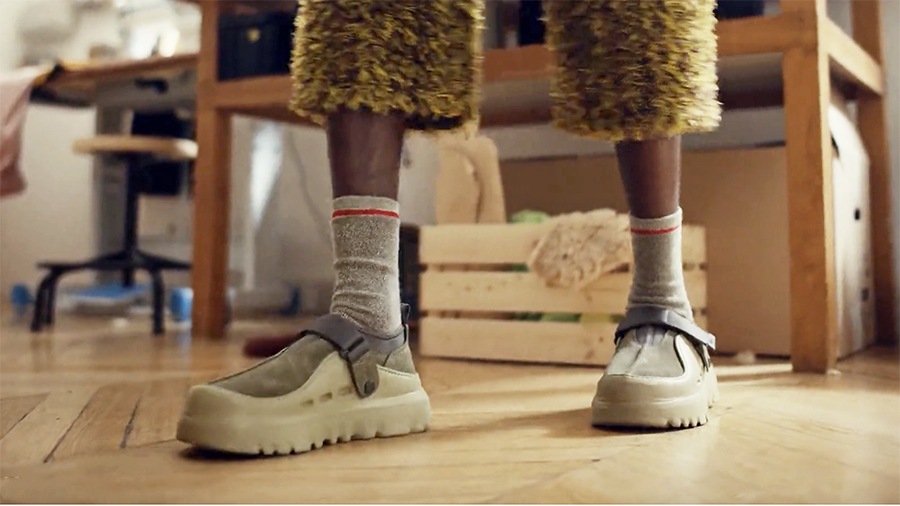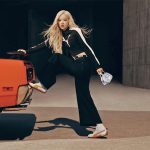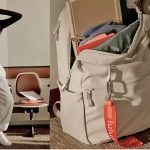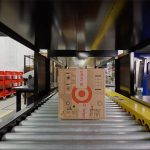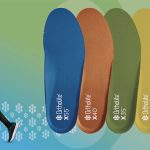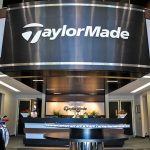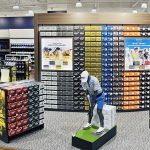Deckers Brands President and CEO Stefano Caroti declared that fiscal year 2026 was off to a solid start for Deckers with Hoka and Ugg both outperforming the first quarter expectations the company set forth on its year-end conference call with analysts.
“In the first quarter, our brands gained market share while maintaining a high degree of full price integrity,” Caroti said on the company’s first quarter call. Hoka delivered its largest quarter in its history, driving strong sell-throughs during this period of key model transitions. We continue to make disciplined and strategic investments in our brands, and our teams tightly managed spend in other areas of the business to provide flexibility.”
Consolidated company global revenue jumped 16.9 percent to $964.5 million for the quarter ended June 30, outpacing the expectations of Wall Street where analysts estimated for $899.1 million in Q1 revenue. Earnings also beat the Street, with EPS reached 93 cents a share for the quarter easily surpassing Wall Street estimates for just 68 cents per share.
DECK shares were up more than 13 percent in overnight trading after falling nearly 3 percent in trading on Thursday, July 24.
Caroti the strength of the business continues to be driven by the “remarkable growth” in international markets with Hoka and Ugg both contributing to the company’s 49.7 percent increase in international revenue, while navigating “a choppy U.S. consumer environment.
Hoka Brand
Global Hoka brand revenue in the first quarter increased 19.8 percent to $653.1 million, compared to $545.2 million in the prior-year Q1 period.
“Hoka performance came in ahead of our expectations, but the shape of the brand’s revenue growth versus last year was aligned with what we had anticipated.” Caroti shared.
Hoka’s global Wholesale reportedly increased 30 percent, said to be driven primarily by the strength of the international business, with Caroti emphasizing the U.S. also contributed to the growth for the quarter.
“[Hoka] DTC increased 3 percent globally with international regions maintaining momentum, which was partially offset by ongoing pressure in the U.S. online channel as previously forecasted,” Caroti noted.
The CEO said the Hoka brand’s international business continues to drive “exciting and broad-based growth” across all regions in both DTC and Wholesale.
EMEA contributed the most meaningful incremental dollar growth as Europe reported record quarterly Wholesale reorders and DTC continued to be fueled by gains in consumer acquisition and retention.
The APAC region was also said to be “delivering impressive growth” as Hoka further penetrates the market with mono-brand partner stores as well as owned-retail stores in China.
In the U.S., Hoka performance was said to be aligned with expectations. “Marketplace dynamics are generally playing out as anticipated amid key franchise upgrades, resulting in the brand experiencing a similar quarter relative to the one [quarter] prior,” Caroti said.
“From a U.S. Wholesale perspective, performance continues to reflect our disciplined approach to marketplace management,” the CEO explained. “Hoka is driving revenue growth from increased sell-in, additional doors with key partners to satisfy greater in-store demand and reorders as sell-through in the channel continue to outpace revenue growth.”
Caroti said the Hoka brand’s ongoing success within the Wholesale channel highlights a continued shift in U.S. consumer shopping preferences toward in-person retail experiences.
“Our observations indicate that while consumers often search for deals online, brick-and-mortar stores remain the primary venue for full price sales, aligning with the feedback received from our retail partners,” he noted. “Our continued journey to thoughtfully expand wholesale doors plays well into this marketplace dynamic, providing Hoka the opportunity to build share and strengthen partnerships with key customers.”
Caraoti said Deckers, on a much smaller scale, is also continuing to “selectively expand” its owned-retail locations in key cities around the world as the brand seeks to build direct relationship with consumers and offer experiences that showcase the full breadth of the Hoka brand product offering.
“These strategies help Hoka gain visibility and solidify its position as the leading running brand in the U.S., although they create short-term pressure on DTC due to our limited retail presence and reliance on e-commerce,” he reasoned. “Over time, we expect our DTC business to benefit from the conversion of newly acquired consumers to loyal repeat purchasers. In addition to the channel dynamics affecting Hoka, we have proactively identified opportunities for improved execution in response to evolving U.S. consumer trends.”
With respect to current franchise upgrades, Caroti said the “consumer signals” they are seeing for Bondi, Clifton and Arahi are quite positive.
“Bondi and Clifton are driving consistent and healthy sell-through in the global marketplace across channels and segments of distribution, evidenced by representing the top two running franchises in the U.S., according to Circana, driving very strong reorders and representing the top sellers among acquired and retained customers in EMEA and doubling year-over-year volumes in China for the spring/summer ’25 season,” he added.
Building off the success of Clifton and Bondi, Caroti said the Arahi 8 update has also been a success since launching at the beginning of July.
“Early feedback in the U.S. has been very positive on the improved fit and feel, with particularly strong initial selling in the run specialty channel and in DTC,” he detailed. “EMEA has experienced double-digit weekly sell-throughs since launch, and China has seen significant volume gains on this model versus last year, performing well ahead of plan for the first two weeks of July. While still early, we’re very pleased with the initial results.”/.
Caroti said the consumer is showing a strong affinity for the updates to the Hoka brand’s three largest franchises.
“We continue to believe there is more work to be done to build the same heat in other franchises across our compelling product assortment. We believe the Hoka brand’s point of differentiation to the consumer is its relentless focus on innovation that delivers transformational experiences,” he suggested.
“To continue delivering the level of innovation consumers have come to expect from Hoka, we have bolstered capabilities across design, innovation, color and lifestyle, allowing for greater dedicated resources to enhance a broader range of styles. As a result, we’re seeing tangible improvements to the product pipeline, which is reflected in the positive retailer response to our Spring/Summer ’26 offering.”
The CEO added that the brand also expects to significantly enhance its ability to segment the marketplace with greater product ammunition, allowing Hoka to fuel DTC acquisition through differentiation and expand Wholesale doors in a controlled manner as the company continues to build awareness and broaden demand for the Hoka brand.
“As a relatively young brand, Hoka remains committed to applying insights gained from our experiences to drive future growth and development,” he continued. “Recognizing some of the execution challenges we faced over the last six months, we’re implementing changes that include adjusting product life cycles to ensure a steady and balanced introduction of new products across key categories, timed to coincide with major shopping periods while providing greater separation between launch dates for our largest franchises, tightening marketplace inventory targets on outgoing models ahead of product updates and enhancing our Hoka DTC loyalty program to more effectively differentiate the DTC experience. It will take time for the benefits of these actions to meaningfully impact our business.”
Ugg Brand
Ugg brand global revenue in the fiscal first quarter ended June 30 increased 18.9 percent to $265.1 million, compared to $223.0 million in the year-ago Q1 period. From a channel perspective, Ugg DTC (director-to-consumer) outperformed Ugg Wholesale, which increased 30 percent year-over-year with consistent growth across the U.S. and international regions. DTC decreased 1 percent as the company continues to see pressure in the U.S. related to consumer sentiment and in-store shopping preferences, offset by continued strong international growth momentum.
“The main drivers of Ugg growth this quarter came from our focus areas,” shared Caroti. “International drove the bulk of growth for Ugg this quarter with EMEA and China contributing the largest year-over-year gains. Men’s footwear grew at nearly twice the overall brand rate and sandal sneaker styles drove most of the growth, reflecting the success of Ugg’s 365 initiative. Although Q1 is primarily a selling quarter for the brand, we’re encouraged by the robust start in Wholesale, a positive early indicator of consumer interest as partners look to accelerate shipments.”
Caroti said Ugg products continue to gain relevance during transitional periods, reflecting “the brand’s ongoing success in developing collections that align with consumer preferences.” He said they were particularly optimistic about the consistency of what has been working in key regions around the world.
“The [Ugg] team has effectively implemented a brand-led global marketplace strategy, delivering elevated experiences through distinctive Ugg products around the world. [Ugg’s] brand focus on telling fewer, more targeted stories to amplify launches is demonstrating measurable success,” he added.
Caroti said the consumer response to the PeakMod style is a perfect example of the team’s efforts in driving positive results.
“The PeakMod is a completely new men’s-specific clog that takes design queues from popular Ugg styles,” The CEO explained. “It initially soft launch in March on the heels of our first-ever men’s focused spring marketing campaign and was then featured as part of our seasonal Icons Reimagined marketing campaign. This versatile style quickly became a male consumer favorite across the U.S., EMEA and China, even earning placement in major fashion publications as a go-to style for more and more their attire.”
He said they believe there are four key reasons for the success: infusing Ugg brand codes into a versatile design, leveraging consumer insights early and frequently, continue to edit the assortment to allow for more focused seasonal stories, and pursuing a long-term strategy to acquire more male consumers.
With respect to the company’s 365 initiative, Caroti said Ugg achieved strong global growth within the sandal and sneaker segments through the Golden collection, which generated significant consumer interest, particularly in the new Goldenstar Glide and Villa styles that commanded higher retail prices compared to existing silhouettes, and the Lowmel franchise, which he said “effectively blends the distinctive Ugg aesthetic and comfort with adaptable wearability.”
As we move into late summer and early fall, despite ongoing concerns affecting the U.S. consumer sentiment,
Caroti said the Ugg brand is strategically positioned within the global marketplace to achieve growth in the second half of calendar year 2025.
“To provide more context, we have operated with lean marketplace inventory for the Tasman franchise, maintaining scarcity ahead of its core selling season,” he detailed. “In addition, Ugg will be launching its iconic design campaign to build heat and generate buzz for versatile footwear in advance for Ugg season with activation planned in key cities around the world.”
The CEO said Ugg begins this transitional period with three key product stories, leveraging its iconic mustard seat colorway on key styles, including the Lowmel Sneaker, Uggbraid clog and all-new Classic Micro.
“Early feedback on all three styles is very positive, and we anticipate more exciting Ugg launches this fall. The team executed the first quarter very well, reinforcing our confidence in achieving another strong year for this powerful brand,” he concluded.
Other Brands
The Other Brands segment, which includes Teva and Ahnu, decreased 19.0 percent to $46.3 million in the fiscal first quarter, compared to $57.2 million in the fiscal 2025 first quarter.
Channel
- Wholesale net sales increased 26.7 percent to $652.4 million compared to $514.8 million.
- DTC net sales increased 0.5 percent to $312.2 million compared to $310.6 million. DTC comparable net sales decreased 2.2 percent.
Geography
- Domestic net sales decreased 2.8 percent to $501.3 million in Q1, compared to $515.9 million in fiscal Q1 2025.
- International net sales increased 49.7 percent to $463.3 million in Q1, compared to $309.5 million in the year-ago quarter.
Profitability
- Gross margin was 55.8 percent compared to 56.9 percent.
- SG&A expenses were $372.6 million compared to $337.2 million.
- Operating income was $165.3 million compared to $132.8 million.
- Diluted earnings per share was 93 cents compared to 75 cents in the year-ago Q1 period.
As previously disclosed, the company effected a six-for-one forward stock split of its common stock during the second fiscal quarter ended September 30, 2024. The share, per share, and resulting financial amounts in this press release have been adjusted to reflect the effectiveness of the stock split.
Balance Sheet (June 30, 2025 as compared to June 30, 2024)
- Cash and cash equivalents were $1.720 billion compared to $1.438 billion.
- Inventories were $849.4 million compared to $753.3 million.
- The company had no outstanding borrowings.
Capital Allocation
During the first fiscal quarter, the company repurchased approximately 1.7 million shares of its common stock for a total of $183.0 million at a weighted average price paid per share of $109.84. As of July 10, 2025, the company had approximately $2.4 billion remaining under its stock repurchase authorization.
Second Quarter Fiscal 2026 Outlook for the Three Month Period Ending September 30, 2025
Given the continued uncertainty from evolving global trade policy and related macroeconomic pressures, the company will only be providing second quarter guidance. The following represents management’s current outlook.
- Net sales are expected to be in the range of $1.38 billion to $1.42 billion, up in the range of 5.1 percent to 4 percent versus $1.31 billion a year ago. Analysts’ consensus estimate had been $1.4 billion.
- Diluted earnings per share is expected to be in the range of $1.50 to $1.55, down from $1.59 a year ago. Analysts’ consensus estimate had been $1.51.
Image courtesy Ugg / Deckers Brands

